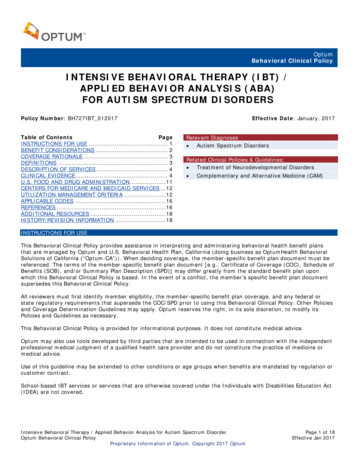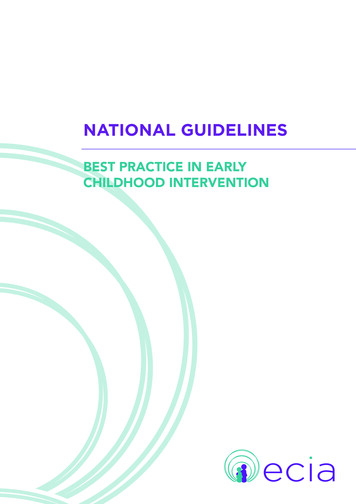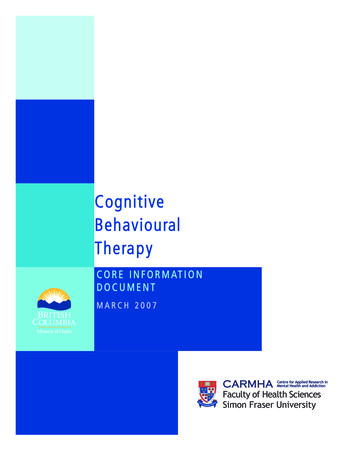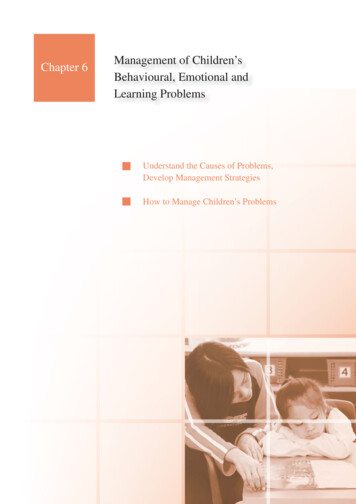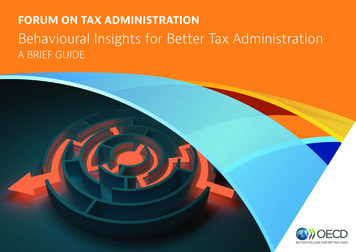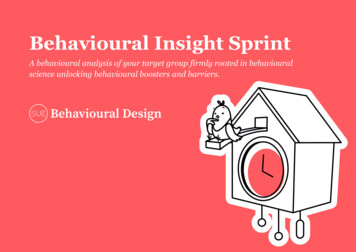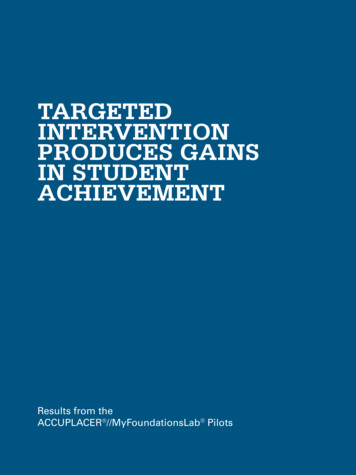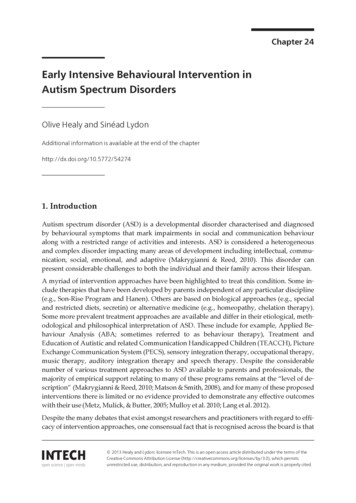
Transcription
Chapter 24Early Intensive Behavioural Intervention inAutism Spectrum DisordersOlive Healy and Sinéad LydonAdditional information is available at the end of the chapterhttp://dx.doi.org/10.5772/542741. IntroductionAutism spectrum disorder (ASD) is a developmental disorder characterised and diagnosedby behavioural symptoms that mark impairments in social and communication behaviouralong with a restricted range of activities and interests. ASD is considered a heterogeneousand complex disorder impacting many areas of development including intellectual, commu‐nication, social, emotional, and adaptive (Makrygianni & Reed, 2010). This disorder canpresent considerable challenges to both the individual and their family across their lifespan.A myriad of intervention approaches have been highlighted to treat this condition. Some in‐clude therapies that have been developed by parents independent of any particular discipline(e.g., Son-Rise Program and Hanen). Others are based on biological approaches (e.g., specialand restricted diets, secretin) or alternative medicine (e.g., homeopathy, chelation therapy).Some more prevalent treatment approaches are available and differ in their etiological, meth‐odological and philosophical interpretation of ASD. These include for example, Applied Be‐haviour Analysis (ABA; sometimes referred to as behaviour therapy), Treatment andEducation of Autistic and related Communication Handicapped Children (TEACCH), PictureExchange Communication System (PECS), sensory integration therapy, occupational therapy,music therapy, auditory integration therapy and speech therapy. Despite the considerablenumber of various treatment approaches to ASD available to parents and professionals, themajority of empirical support relating to many of these programs remains at the “level of de‐scription” (Makrygianni & Reed, 2010; Matson & Smith, 2008), and for many of these proposedinterventions there is limited or no evidence provided to demonstrate any effective outcomeswith their use (Metz, Mulick, & Butter, 2005; Mulloy et al. 2010; Lang et al. 2012).Despite the many debates that exist amongst researchers and practitioners with regard to effi‐cacy of intervention approaches, one consensual fact that is recognised across the board is that 2013 Healy and Lydon; licensee InTech. This is an open access article distributed under the terms of theCreative Commons Attribution License (http://creativecommons.org/licenses/by/3.0), which permitsunrestricted use, distribution, and reproduction in any medium, provided the original work is properly cited.
568Recent Advances in Autism Spectrum Disorders - Volume Iearly intervention is the best response to the treatment of ASD. Providing treatment of symp‐toms immediately will result in more favourable treatment outcomes (Dawson, 2008; Howlin,Magiati & Charmin, 2009; Reichow & Wolery, 2009). Many have argued that this early inter‐vention will allow greater opportunities for a young child to move towards a more typical de‐velopmental trajectory because of malleability or plasticity of the developing young brain (seefor example Dawson 2008). From a learning theory account, teaching new behaviour or re‐placement behaviour to a very young child presenting with behavioural deficits or excesses,will result in desirable consequences that impacts behavioural repertoires and learning historyfrom the outset. In this way early intervention for the condition may affect the onset of addi‐tional secondary problem behaviours which are often not seen at diagnosis. As such these maybe minimised or even prevented (Mundy, Sullivan & Mastergeorge, 2009).While a consensus that early intervention for ASD exists amongst researchers in this field,many argue that the actual approach applied during this critical period may be pivotal inproducing the greatest outcomes and ensuring the best chance of attaining a typical devel‐opmental trajectory. Over the past four decades, interventions based on the science of ABAhave been thoroughly evaluated and shown to produce effective outcomes in targetingmany of the challenges presented within this condition. Moreover, behavioural interven‐tions drawn from this science can produce substantial gains in cognitive, adaptive and socialbehaviours in this population (Dillenberger, 2011). Indeed, this approach is internationallyrecognised as the most effective basis for treatment for children with ASD (Larsson, 2005).Improving the core symptoms of ASD is a common goal for parents and professionals. Re‐ports of large improvements in this condition have been documented. For example Smith(1999) provided a summary of published peer-reviewed studies involving seven independ‐ent groups of researchers documenting dramatic gains when early intervention was applied.Importantly however, in all studies reviewed, interventions were underpinned by ABAmethodology and theory and were intensive involving a range of 15 to 40 hours per weekacross studies. This approach to autism treatment, known as Early Intensive Behavioural In‐tervention (EIBI) has generated much discussion and excitement, and continues to gathermomentum impressing on policy makers the urgency of effective and substantiated provi‐sion for individuals and families affected by the condition.Studies on EIBI have reported the following gains: (1) average increases of approximately 20points in IQ (e.g., Harris, Handleman, Gordon, Kristoff, & Fuentes, 1991; Lovaas, 1987;Sheinkopf & Siegal, 1998) (2) increases in standardised test scores (Anderson, Avery, DiPie‐tro, Edwards, & Christian, 1987; Birnbrauer & Leach, 1993; Hoyson, Jamison, & Strain, 1984;McEachin, Smith, & Lovaas, 1993; Strauss et al. 2012), (3) increased gains in adaptive behav‐iour (Eldevik et al., 2012; Strauss et al., 2012); (4) improved language scores (Eldevik et al.,2012; Strauss et al. 2012); (5) the need for less supports in school (Fenske, Zalenski, Krantz, &McClannahan, 1985; Lovaas, 1987), (6) reduced autism symptomotology (Eikeseth et al,.2012) and (7) decreased challenging behaviour (Fava et al., 2012). Dillenberger (2011) refersto the increasing evidence of clinical, social and financial efficiency of intensive behaviouralintervention in autism treatment which has resulted in “legally enshrining” such interven‐tion in North America. For example, the Autism Treatment Acceleration Act (2010) requires
Early Intensive Behavioural Intervention in Autism Spectrum Disordershttp://dx.doi.org/10.5772/54274that health insurers cover the diagnosis and treatment of autism spectrum disorders, includ‐ing access to ABA therapy.2. What constitutes EIBI?EIBI is based on the scientifically applied principles of learning and behaviour, and has the dis‐cipline of behaviour analysis (Cooper, Heron, & Heward, 2007) at its core. The approach gener‐ally targets preschool children and is provided intensively, often in a 1:1 student/teacher ratio,for 20-50 hours per week. Dawson (2008) and Green (1996) summarise many of the commonand conspicuous features of successful EIBI programs. These include the following:1.the EIBI program should be initiated as early as 2 years and before the age of four;2.intensive delivery of the program involving a minimum of 25 hours per week for atleast two years;3.application of a comprehensive curriculum or various curricula, focusing on imitation,language, toy play, social interaction, motor, and adaptive behaviour targets;4.the curricula and their implementation should show sensitivity to typical developmen‐tal sequences;5.generalisation strategies should be incorporated to ensure new skills are practiced anddemonstrated in novel environments outside those in which they were taught;6.use of supportive and empirically validated teaching strategies and data-driven deci‐sion protocols (notably those of Applied Behaviour Analysis);7.implementation of behavioural strategies to reduce or eliminate major interfering be‐haviours that are an impediment to learning new skills and repertoires (noncompliance,inattention, impulsivity, tantrum, aggression and self-injurious behaviours are exam‐ples of some of the most critical of these behaviours).8.a functional analytic approach to treating problem behaviours;9.continual parental involvement and tailored parent education;10. progressive and gradual transition to increasingly naturalistic environments;11. qualified and highly trained staff delivering the program and12. the provision of supervision by qualified over-viewers resulting in ongoing review andsystematic progression of the program.According to Dawson (2008): “When these features are present, results are remarkable for up to50% of children” (p.790).It is important to note that EIBI draws from the bedrock of a science- Applied BehaviourAnalysis (ABA). This science constitutes over 300 procedures (Greer, 2002; Steege, Mace,Perry, and Longenecker, 2007) each of which have been tested and demonstrated to produce569
570Recent Advances in Autism Spectrum Disorders - Volume Ibehaviour change. The careful selection and application of these procedures to treat the be‐havioural symptoms of autism delivered within the scientific framework of ABA (outlinedin Baer, Wolf & Risley, 1968; 1987) is what defines an EIBI approach. It is critical to recognisehow ABA and EIBI are interwoven because the science of ABA and the various behaviourchange strategies therein, have a very long history of substantiated documentation (see forexample Matson, Benavidez, Compton, Paclawskyj, & Baglio, 1996, who reviewed behavior‐ally based treatments for autism over a 16-year span).3. History of EIBIThe history of this early intervention approach to autism has been well documented overthe last three decades. For example, Matson and Smith (2008) trace the origins of this ap‐proach in autism treatment to what they refer to as a “seminal paper” (p.61) published asearly as 1973 by Lovaas, Koegel, Simmons, and Long (1973). Matson and Smith argue thatthis paper demonstrated a visionary conceptual framework for early intervention with ASD.“The true significance of the study was the authors’ efforts to formulate an overarching treatment of children with autism on amultitude of behaviours including self-stimulation/stereotypies, echolalia, appropriate verbal behaviour, social behaviour, appropri‐ate play, intelligence quotient (IQ), and adaptive behaviour” (Matson & Smith, 2008, pp. 61-62).Trends in EIBI, to this day, are based on this original template involving the delivery of idio‐syncratic treatment packages constituting evidence-based behavioural interventions to tar‐get core symptoms as well as expansive groups of behaviours. Numerous studies have beenpublished since this seminal paper in 1973 examining EIBI outcomes in autism. One of themost distinguished and considered published papers which resulted in the acclamation ofEIBI involved that of Lovaas (1987). This well-reviewed study which reported an averagedifference of 31 points on IQ test scores between the ASD treatment group and controlgroup, and classified nine of 19 (47%) participants as having achieved recovery (defined aspost-intervention IQ in the normal range). To this current day, the findings of this studyhave caused much debate among researchers with criticisms focusing on particular meth‐odological limitations (see for example, Gresham and MacMillan 1998; Short & Mesibov,1989). We will return to this study in a later section.To date, a substantial number of studies have been conducted and published to demonstratethe effectiveness of EIBI in autism treatment. Moreover, six illustrative review papers andone “mega-analysis” (a combination of all of the data into one single analysis) have beenpublished (see below), each providing somewhat varying angles in exploring the outcomes.Steady growing rates of publications on the findings of EIBI in autism have been evidencedand concise descriptions of methodology have appeared to improve in most recent years,particularly with respect to the inclusion of control–no treatment groups and random as‐signment of participants across experimental conditions.The current chapter will provide a synopsis of EIBI studies published between 1987-2012.Systematic searches were conducted using the following databases: Scopus, Psychology &Behavioral Sciences Collection, and PsycINFO
Early Intensive Behavioural Intervention in Autism Spectrum Disordershttp://dx.doi.org/10.5772/54274The searches were carried out using the terms “early intensive behavioural interventionAND autism”, and “intensive behavioural intervention AND autism”. The inclusion criteriawere largely in line with those of Reichow (2012). Studies were reviewed if they included atreatment group who received EIBI and an alternate-treatment control group who receivedeither no treatment, a different treatment or EIBI provided at different intensity levels. Onlystudies including children with ASD were reviewed. Each study was required to involveoriginal research that was written in English and published in a peer reviewed journal. Inthe interest of clarity we grouped published investigations under the following headings:Studies published before 2000 (4 studies), studies published from 2000-2010 (12 studies) andstudies published between 2011-2012 (5 studies). We provide a summary of factors associat‐ed with each published paper including intake characteristics of participants, outcomemeasures employed, specific treatment characteristics and group differences following inter‐vention. The following sections provide a synopsis of all studies identified.4. Studies published before 2000 (4 Studies)Lovaas (1987) conducted the first evaluation of EIBI for children with Autism. The outcomesof 19 children receiving EIBI, for a minimum of 40 hours per week, were compared to thoseof two control groups. The first control group, consisting of 19 children, received low inten‐sity (10 hours or less) behavioural intervention and the second control group, consisting of21 children, received TAU. After two years of treatment, 47% of the EIBI group achieved IQscores in the normal range and were enabled to integrate fully into mainstream educationalsettings while only 2% of children in the control group achieved similar outcomes. In thiscase, almost half of children in the EIBI appeared to recover from their diagnosis of autism.Birnbauer and Leach (1992) compared the outcomes of nine children receiving EIBI and fivechildren in a control group (no treatment). Children in the EIBI group received an average of18.7 hours of EIBI per week delivered by trained volunteers in their homes. Children in the EIBIgroup achieved significantly higher non-verbal IQ scores and language levels. Four of the ninechildren in the EIBI group achieved IQ scores within the normal range following treatment.Smith et al. (1997) compared the outcomes of 11 children receiving EIBI to 10 children whoreceived a low intensity behaviour intervention. Children in the high intensity EIBI groupreceived at least 30 hours of clinician-delivered treatment each week while the low intensitygroup received 10 hours of clinician-delivered behavioural intervention each week. At fol‐low-up, the children in the EIBI group showed greater increases in IQ and expressive lan‐guage than children in the control group.Sheinkopf and Siegel (1998) evaluated the outcomes of 11 children receiving EIBI and 11children receiving Treatment as Usual (TAU). EIBI was delivered by parents, supervised byclinicians, for 27 hours each week. Children in the control group received 11.1 hours of TAUin a school setting each week. Following treatment, the EIBI group achieved significantlyhigher IQ scores and significantly lower scores on a measure of symptom severity than thecontrol group.571
572Recent Advances in Autism Spectrum Disorders - Volume IStudyIntake CharacteristicsOutcomeTreatment CharacteristicsGroupGroupnAgeM, FIQVABSELRLMeasuresModelHr/wkLovaas et al.Tx1934.6-62.7---IntellectualUCLA4024 (1987)C1940.9-57.0---Functioning;UCLA1024 groupC21 42-60.0---AcademicTAU-24 achievedTreatmentDifferencesDuration47% of the TxPlacement;normalDiagnosticfunctioning asRecoverycompared to2% of the Cgroups.Birnbauer &Tx938.15,451.346.1--IntellectualLeach thologySmith et al.Tx113611,02850.3--IntellectualUCLA30 35Mean d by 8Speech; Behaviourpoints in the TxProblemsgroup, butdecreased by 3points in the Cgroup. The Txgroup alsomadesignificantlymore progresswith theirspeech.Sheinkopf &Tx1133.8-62.8---IntellectualUCLA27.015.7The Tx groupSiegel (1998)C1135.3-61.7---Functioning; DSMTAU11.118presented withSymptomatologysignificantlyhigher IQfollowingtreatment.Symptomseverity wasalsosignificantlylower in the Txgroup.Table 1. Summary of EIBI studies Pre-2000, M, F (male, female), VABS (Vineland Adaptive Behaviour Scale), EL(Expressive Language), RL (Receptive Language)
Early Intensive Behavioural Intervention in Autism Spectrum Disordershttp://dx.doi.org/10.5772/542745. Studies published from 2000-2010 (12 Studies)Ben-Itzchak et al. (2008) compared the outcomes of 44 children with autism receiving 45 hoursof EIBI weekly and 37children with other developmental disabilities receiving TAU. After oneyear, the children in the EIBI group made significantly greater gains in IQ than the controlgroup. The authors also analysed whether EIBI outcomes were affected by initial cognitive lev‐el. Children were categorised as being of normal, borderline, or impaired IQ. They found thatbaseline cognitive levels did not predict changes in autism symptoms. However, IQ increasesdue to treatment were correlated with reductions in autism symptoms.Remington et al. (2007) compared the outcomes of 23 children who received 25.6 hours ofEIBI with a control group in which 21 children received an average of 15.3 hours of interven‐tion weekly. After two years of treatment, children in the EIBI group made showed signifi‐cantly greater increases in mental age, intellectual functioning, language functioning,adaptive functioning and positive social behaviours.Reed et al. (2007a) compared the impact of high-intensity and low-intensity home-based EI‐BI. The high-intensity group was composed of 14 children who each received 30.4 hours ofintervention per week. There were 13 children in the low-intensity group who each receivedan average of 12.6 hours of intervention weekly. The high-intensity group made significant‐ly greater gains on measures of intellectual and educational functioning. However, the chil‐dren in the low-intensity EIBI group did show significant improvements in educationalfunctioning at follow-up.Reed et al. (2007b) compared the outcomes of children who had received EIBI, “eclectic” in‐tervention, or portage. The 12 children in the EIBI group received an average of 30.4 hoursof home-based intervention each week, the 20 children in the “eclectic” group received amean of 12.7 hours per week, and the 16 children in portage group received 8.5 hours ofweekly intervention. At follow-up, the EIBI group outperformed both groups on measuresof educational functioning while both the EIBI group and the “eclectic” group scored signifi‐cantly higher on measures of intellectual functioning than the portage group.Given the previous considerations, the current study directly compared the impact of exist‐ing ABA, special nursery placements, and portage programs on a variety of aspects of thechildren's abilities. The latter two were selected because special nursery placement is a com‐monly occurring program offered to children with ASD, which has received little direct as‐sessment in terms of its effectiveness. Portage was chosen as, again, it is increasingly offeredto children with ASD (see Reed et al., 2000; Smith, 2000). The portage intervention also al‐lows comparison of a very intensive intervention (ABA) with a less intensive intervention(portage) in a community-based setting. This comparison formed part of the original clinicbased study conducted by Lovaas (1987), and the current comparison allows assessment ofthe generalization to a community-based sample. However, the intensity of hours of treat‐ment delivery varied greatly between the three interventions and this can make it difficult to“tease out” whether it was the nature of the intervention or simply the duration of treatmentthat accounted for the differences in outcomes reported.573
574Recent Advances in Autism Spectrum Disorders - Volume IMagiati et al. (2007) conducted a prospective comparison of 28 children who received 32.4hours EIBI each week and 16 children who received 25.6 hours of autism-specific nursery pro‐vision each week. The EIBI group received parent-delivered intervention with training and su‐pervision provided by clinicians. At follow-up, both groups achieved similar outcomesalthough the EIBI group scored significantly higher on the VABS Daily Living Skills subscale.Eldevik et al. (2006) retrospectively compared the outcomes of 13 children receiving EIBIand 15 children receiving “eclectic” intervention. The EIBI group typically received 12.5hours of intervention each week. Parent training was also provided to increase maintenanceand generalisation of skills. The control group received 12 hours of intervention each week.The EIBI group outperformed the control group on measures of IQ, language functioning,and communication at the follow-up. They also presented with less symptoms of pathologythan children in the control group.Eikeseth et al. (2007) compared the outcomes of 13 children who received 28 hours of EIBIweekly with 12 children who received 29.1 hours of “eclectic” intervention each week. Atfollow-up, the children who had received EIBI showed significantly greater improvementsin IQ, adaptive functioning, and presented with less social and behaviour problems.Cohen et al. (2006) compared the outcomes of 21 children receiving 35-40 hours of EIBI perweek to a control group of 21 children receiving “eclectic” interventions. Parents imple‐menting EIBI received training so that they could use behavioural techniques in the homesetting. Following the treatment phase, the EIBI group achieved significantly higher scoreson measures of IQ, adaptive functioning, and receptive language. 17 children from the EIBIgroup transitioned to mainstream education settings as compared to 1 child from the controlgroup.Sallows and Graupner (2005) compared the effects of clinic-directed EIBI and parent-direct‐ed EIBI. This study was the only study we found in our search that directly compared themode of EIBI delivery. All others either employed an alternate treatment comparison or acontrol-no treatment comparison. The 13 children in the clinic-directed EIBI group receivedan average of 37.6 hours of intervention weekly while the10 children in the parent-directedEIBI group typically received 31.6 hours of intervention. Both groups received a UCLAbased intervention (often referred to “Lovaas therapy” based on the original study in 1987).The groups made similar gains on outcome measures suggesting that the less costly parentdirected intervention was equally effective. It was found that 48% of participants showedrapid learning, achieved normal scores on outcome measures, and, at follow-up, were suc‐ceeding in mainstream classrooms. Pre-treatment imitation, language, daily living skills,and socialization were found to be predictive of outcome.Howard et al. (2005) compared the effects of EIBI, intensive “eclectic” intervention, and low-in‐tensity “eclectic” intervention. The 29 children assigned to the EIBI group received 25-40 hoursof EIBI each week and their parents received training so that teaching could extend to the homesetting. The 16 children in the intensive “eclectic” intervention group received 25-30 hours ofintervention each week, while the 16 children in the low-intensity “eclectic” group received 15hours of intervention each week. The EIBI group achieved significantly higher scores on meas‐ures of intellectual functioning, visual spatial skills, language functioning and adaptive func‐tioning. The outcomes of the two “eclectic” control groups did not differ.
Early Intensive Behavioural Intervention in Autism Spectrum e CharacteristicsOutcome MeasuresGroupnAgeM, FIQVABSELRLSmith et al.Tx1536.112, 350.563.441.937.3(2000)C1335.811, 250.765.245.638.3Treatment IntellectualUCLA24.533.4The Tx groupFunctioning; Visual-UCLA15-2024made significantlyDurationSpatial Skills;greater gains inLanguageIQ, visual-spatialFunctioning;skills, andAdaptivelanguageFunctioning;development. TheSocioemotionalTx group tendedFunctioning;to make greaterAcademicacademicAchievement; Classachievements andPlacement; Progressto be in lessin Treatment; seth et alTx1366.38, 265.011, 165.260.051.250.4Functioning; Visual-Eclectic29.113.6The Tx groupachievedSpatial Skills;significantlyLanguagehigher scores thatFunctioning;the C group on allAdaptivemeasures, exceptFunctioningthe VABSsocializationsubscale and thedaily livingsubscale. Childrenin the Tx grouphad significantlyfewer disruptivebehaviours thanthe C group atfollow-up.Howard et al.Tx2930.925, 458.570.5(2005)C1637.413, 353.769.8C1634.616, 059.971.651.952.2IntellectualEIBI25-4014.2The outcomes of43.945.448.849.0Functioning; Visual-Eclectic25-3013.3the two eclectic CSpatial Skills;Eclectic1514.8groups did notLanguagediffer. The TxFunctioning;group performedAdaptivesignificantlyFunctioningbetter on allmeasures, exceptmotor skills thanthe C groups.575
576Recent Advances in Autism Spectrum Disorders - Volume IStudyIntake CharacteristicsOutcome MeasuresGroupnAgeM, FIQVABSELRLTx1335.011, 250.959.547.938.9Treatment ferencesDurationSallows &Intellectual48Both Tx imilarly on ; SocialFunctioning;AcademicFunctioningCohen et al.Tx2130.218, 361.669.852.951.7IntellectualUCLA35-4036The Tx group(2006)C2133.217, 459.470.652.852.7Functioning; Visual-Eclectic--made significantlySpatial Skills;greater gains inLanguageIQ, receptiveFunctioning;language, andAdaptiveadaptiveFunctioning;functioning. 17Academicchildren from thePlacementTx group wereincluded inmainsteameducation settingsas compared to 1child in the Cgroup.Eldevik et al.Tx1353.010, 49.014, 147.252.541.633.2Functioning;Eclectic12.021.4The Tx groupsignificantlyLanguageoutperformed theFunctioning;C group onAdaptiveintellectualFunctioning; Visualfunctioning,Spatial Skills;languagePathology; Degreefunctioning, andof IntellectualtheDisabilitycommunicationsubscale of theVABS. The Txgroup alsoshowedsignificantly lesspathology at thefollow-up
Early Intensive Behavioural Intervention in Autism Spectrum e CharacteristicsOutcome MeasuresGroupnAgeM, FIQVABSELRLEikeseth et al.Tx1366.38, 561.955.845.149.0(2007)C1265.011, 165.260.051.250.4Treatment esDurationAdaptiveThe Tx otionalimprovements inFunctioningIQ, adaptivefunctioning, socialbehaviour, andaggressivebehaviour.Magiati et al.Tx2838.027, 183.059.62.2 (r)4.9 (r)Visual-Spatial Skills;UCLA32.425.5(2007)C1642.512, 465.255.41.7 (r)2.9 (r)IntellectualEclectic25.626.0Functioning;Both ning;However, the TxLanguagegroup achievedFunctioning; PlaysignificantlySkills; Autismhigher scores onSymptomatologythe VABS DailyLiving Skillssubscales. Largeintra-groupvariation inresponse totreatment wasobserved.Reed et al.Tx1442.914, 060.159.3--AutismEIBI30.49-10The Tx group(2007a)C1340.813, 056.656.5--Symptomatology;EIBI12.69-10made significantlyDevelopmentalgreater gains onFunctioning;intellectualIntellectualfunctioning tioningalthough the Cgroup did showsignificantimprovements oneducationalfunctioning.Reed et al.Tx124011, 156.858.2--AutismEIBI30.49Those in the Tx(2007b)C204318, 257.853.0--Symptomatology;Eclectic12.79group icantly577
578Recent Advances in Autism Spectrum Disorders - Volume IStudyIntake CharacteristicsGroupnAgeM, FIQOutcome MeasuresVABSELRLTreatment DurationFunctioning;greater gains thanIntellectualthe portageFunctioning;group onAdaptiveintellectualFunctioning;functioning andComorbid Problemsmade greatergains than both Cgroups oneducationalfunctioning.Remington etTx2335.7-61.4114.8 (r)--IntellectualEIBI25.624al. (2007)C2138.4-62.3113.6 (r)--Functioning;TAU15.324The Tx r increasesAdaptivein mental Nonverbal SociallanguageCommunication;functioning,Parental Wellbeingadaptivefunctioning, andpositive socialbehaviours.Ben-ItzchakTx4427.343, 174.8---et al. (2008)C3724.223, 1471.0---IntellectualEIBI4512Functioning; AutismTAU-12The Tx groupmade significantlySymptomatology (Txgreater gains in IQgroup only)than the C group.Table 2. Summary of EIBI studies 2000-2010, M, F (male, female), VABS (Vineland Adaptive Behaviour Scale), EL(Expressive Language), RL (Receptive Language), (r) (raw scores)Eikeseth et al. (2002) compared the outcomes of EIBI and “eclectic” treatment for childrenwith autism after one year of intervention. The 13 children in the EIBI group received anaverage of 28 hours of intervention each week in a school setting. Parents were trained for aminimum of
ally based treatments for autism over a 16-year span). 3. History of EIBI The history of this early intervention approach to autism has been well documented over the last three decades. For example, Matson and Smith (2008) trace the origins of this ap‐ proach in autism treatment to what they refer to as a "seminal paper" (p.61) published as
